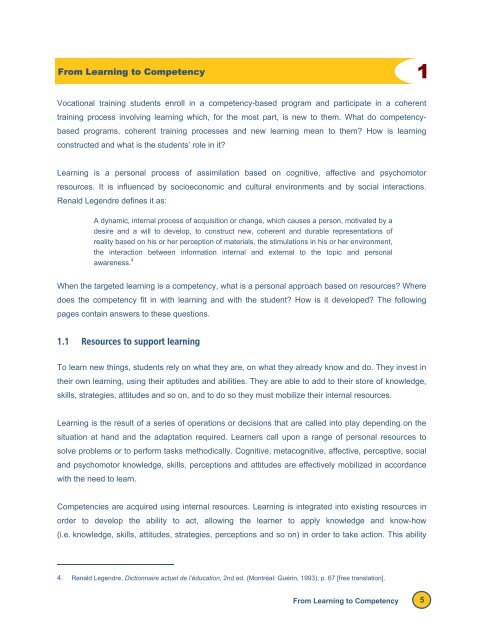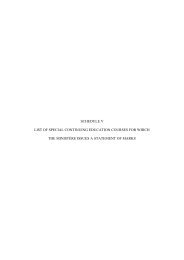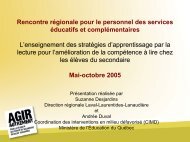Reference Framework for Planning Learning and Evaluation Activities
Reference Framework for Planning Learning and Evaluation Activities
Reference Framework for Planning Learning and Evaluation Activities
Create successful ePaper yourself
Turn your PDF publications into a flip-book with our unique Google optimized e-Paper software.
From <strong>Learning</strong> to Competency<br />
1<br />
Vocational training students enroll in a competency-based program <strong>and</strong> participate in a coherent<br />
training process involving learning which, <strong>for</strong> the most part, is new to them. What do competencybased<br />
programs, coherent training processes <strong>and</strong> new learning mean to them How is learning<br />
constructed <strong>and</strong> what is the students’ role in it<br />
<strong>Learning</strong> is a personal process of assimilation based on cognitive, affective <strong>and</strong> psychomotor<br />
resources. It is influenced by socioeconomic <strong>and</strong> cultural environments <strong>and</strong> by social interactions.<br />
Renald Legendre defines it as:<br />
A dynamic, internal process of acquisition or change, which causes a person, motivated by a<br />
desire <strong>and</strong> a will to develop, to construct new, coherent <strong>and</strong> durable representations of<br />
reality based on his or her perception of materials, the stimulations in his or her environment,<br />
the interaction between in<strong>for</strong>mation internal <strong>and</strong> external to the topic <strong>and</strong> personal<br />
awareness. 4<br />
When the targeted learning is a competency, what is a personal approach based on resources Where<br />
does the competency fit in with learning <strong>and</strong> with the student How is it developed The following<br />
pages contain answers to these questions.<br />
1.1 Resources to support learning<br />
To learn new things, students rely on what they are, on what they already know <strong>and</strong> do. They invest in<br />
their own learning, using their aptitudes <strong>and</strong> abilities. They are able to add to their store of knowledge,<br />
skills, strategies, attitudes <strong>and</strong> so on, <strong>and</strong> to do so they must mobilize their internal resources.<br />
<strong>Learning</strong> is the result of a series of operations or decisions that are called into play depending on the<br />
situation at h<strong>and</strong> <strong>and</strong> the adaptation required. Learners call upon a range of personal resources to<br />
solve problems or to per<strong>for</strong>m tasks methodically. Cognitive, metacognitive, affective, perceptive, social<br />
<strong>and</strong> psychomotor knowledge, skills, perceptions <strong>and</strong> attitudes are effectively mobilized in accordance<br />
with the need to learn.<br />
Competencies are acquired using internal resources. <strong>Learning</strong> is integrated into existing resources in<br />
order to develop the ability to act, allowing the learner to apply knowledge <strong>and</strong> know-how<br />
(i.e. knowledge, skills, attitudes, strategies, perceptions <strong>and</strong> so on) in order to take action. This ability<br />
4. Renald Legendre, Dictionnaire actuel de l’éducation, 2nd ed. (Montréal: Guérin, 1993), p. 67 [free translation].<br />
From <strong>Learning</strong> to Competency 5




